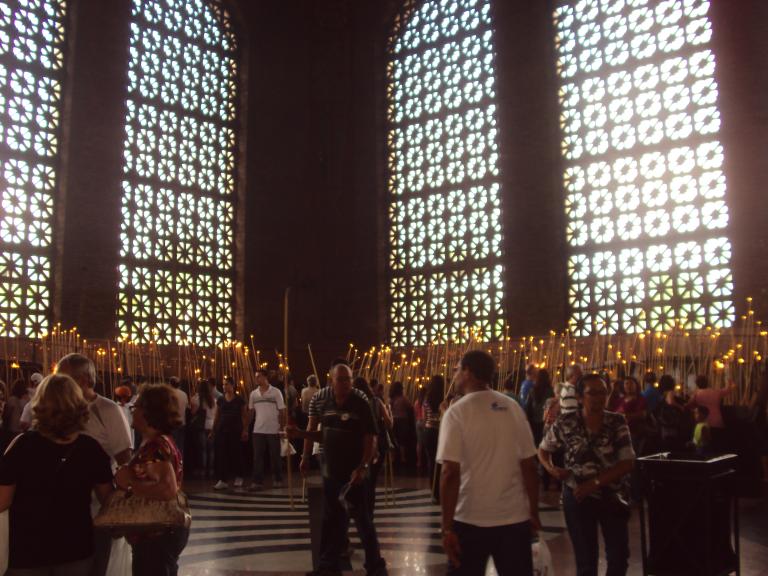
The Marian spirituality of the Church in Latin America is everywhere to see, particularly in the several national shrines across the continent.
Many Americans are familiar with Our Lady of Guadalupe in Mexico City but may not be aware of Our Lady of Lujan (in Argentina), Our Lady of Charity of El Cobre (in Cuba) or Our Lady of Aparecida (in Brazil), among others.
The Aparecida shrine — a national cathedral — is the second largest basilica in the world and the largest Marian shrine, seating 45,000 people, and receiving an estimated 10 million pilgrims annually.
It was here in May 2007 that the fifth CELAM conference of the Latin American and Caribbean bishops was held. (We might remember that these clerics represent 40% of the world Church.) Pope Benedict XVI made the introductory remarks while then-Cardinal Bergoglio was elected by the bishops as chairman of the committee to write the final document.
The Aparecida Document has turned out to be an interpretive key to the papacy of Pope Francis: he has referred to it as “a treasure yet to be fully exploited”, even as three of his own key statements are heavily inspired by Aparecida: Evangelii Gaudium, Laudato Si’, and Amoris Laetitia.
It is arguably the experience that created what historian Austin Ivereigh has called “The Francis Option.” And its prophetic power is helping to drive the deliberations at this month’s Amazonian Synod in Rome.
Part of the historical background to the Aparecida conference was the Argentinian crisis of 2001, a catastrophe of failed capitalism which had a great impact on the worldviews of Pope Francis and many other Latin American observers.
Another was the end of the Cold War and its various associated repressions of the politics around poverty: a revised, de-Marxified version of liberation theology was able to re-emerge.
We can now see the groundbreaking way these bishops, working from their distinctly Latin American experiences, called in 2007 for a unified way of finally engaging the powerful forces of technocracy, globalization, inequality, ecological disaster, mass migrations, and the decline of nation-states.
In a spirit of self-criticism of the Church, the document also stated (in section n. 12):
… A Catholic faith reduced to mere baggage, to a collection of rules and prohibitions, to fragmented devotional practices, to selective and partial adherence to the truths of the faith, to occasional participation in some sacraments, to the repetition of doctrinal principles, to bland or nervous moralizing, that does not convert the life of the baptized would not withstand the trials of time.
Key themes of the document could be summarized as:
- Importance of the personal encounter (a personalist approach to evangelism, especially developed in the work of the Argentine philosopher Enrique Dussel)
- A new missionary drive to go out to the “peripheries,” including the areas of the indigenous peoples as well urban ministries, along with mission not as a program but as a permanent and paradigmatic way of being
- A recovery of the theological (not merely social) emphasis on the preferential option for the poor and marginalized
- Living with the simplicity and humility taught in the Gospel (see my earlier post on the relevant Pact of the Catacombs)
- Serious commitment to the environment, especially the region of Amazonia
- Commitment to teología del pueblo, ”theology of the people,” emphasizing not Marxism but instead the importance of culture, popular religiosity and popular mysticism
There is of course much more which could be said here of Aparecida and other influences behind the Synod, including the way it was transported onto the larger canvas of the global Church by Pope Francis. These are the same themes we are hearing about in these opening days of the Synod, with more coming later in the month.
More on the Synod shortly.
For now, and relevant to the ethos of this event, I’d like to close with a personal anecdote from my trip to Rio in June 2013 for World Youth Day, a formative experience I’m still working through, one in which the beauty of the global Church became visible before my (and my two young daughters’) eyes.
As a speaker at a symposium on “Christ and the Environment” during the week of World Youth Day, I stayed at a wonderful guesthouse in the bohemian-chic Rio neighborhood called Santa Teresa, along with a number of other panelists and speakers, from Mexico, Spain, Argentina, Peru, Columbia, and Brazil, among other countries.
On one evening, we all had a dinner together and then talked for a bit until someone pulled out a guitar. What followed was mostly raucous and comical, as we sang bad versions of Beatles songs, folk songs, and nonsense.
But near the end of the evening, the guitarist began playing a song I’d never heard, Santa Maria de America Latina. It’s a simple Marian folk song, each verse of which is devoted to a different shrine in a different country: Panama, Cuba, Mexico, Peru, Chile, Brazil, Argentina, Venezuela, Ecuador, Colombia, Guatemala, Costa Rica, Honduras. (I’ll paste in the lyrics in Spanish and English below.)
But as much as the tenderness of the song, what struck me in that Rio setting among new friends from numerous countries was the spontaneous way some seven or eight different Hispanic men — teachers, theologians, laypeople — all apparently knew the song through all its verses. It felt like a small example of just what the teología del pueblo refers to, i.e., an instinctive devotion not created by any committee but from the hearts of the people.
Personally, I feel these currents very strongly in what we’re watching at this month’s Amazonian Synod.
[English/Spanish lyrics of “Santa María de América Latina”]















